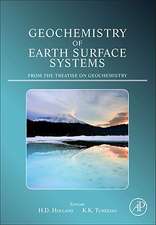The Inaccessible Earth: An integrated view to its structure and composition
Autor Geoffrey Brownen Limba Engleză Paperback – 13 noi 2013
Preț: 391.99 lei
Nou
Puncte Express: 588
Preț estimativ în valută:
75.03€ • 81.53$ • 63.07£
75.03€ • 81.53$ • 63.07£
Carte tipărită la comandă
Livrare economică 21 aprilie-05 mai
Preluare comenzi: 021 569.72.76
Specificații
ISBN-13: 9789401046626
ISBN-10: 940104662X
Pagini: 292
Ilustrații: XI, 276 p. 121 illus.
Dimensiuni: 178 x 254 x 15 mm
Greutate: 0.51 kg
Ediția:Softcover reprint of the original 1st ed. 1993
Editura: SPRINGER NETHERLANDS
Colecția Springer
Locul publicării:Dordrecht, Netherlands
ISBN-10: 940104662X
Pagini: 292
Ilustrații: XI, 276 p. 121 illus.
Dimensiuni: 178 x 254 x 15 mm
Greutate: 0.51 kg
Ediția:Softcover reprint of the original 1st ed. 1993
Editura: SPRINGER NETHERLANDS
Colecția Springer
Locul publicării:Dordrecht, Netherlands
Public țintă
ResearchCuprins
1 Introduction.- 1.1 Aims and objectives.- 1.2 ‘The Inaccessible Earth’: an outline.- 1.3 History of ideas about the Earth.- Further reading.- 2 The contribution of seismology.- 2.1 Seismic waves.- 2.2 Deduction of P- and S-wave velocities at depth.- 2.3 Seismic velocities and the structure of the Earth.- 2.4 Surface waves.- 2.5 Free oscillations of the Earth.- Summary.- Further reading.- 3 The density within the Earth.- 3.1 Introduction.- 3.2 The mass of the Earth.- 3.3 The moment of inertia of the Earth.- 3.4 The simple self-compression model: the Adams—Williamson equation.- 3.5 Defects of the self-compression model.- 3.6 More sophisticated models and a contemporary result for the Earth’s density variation.- Summary.- Further reading.- 4 The formation of the Solar System and the abundances of the elements.- 4.1 Why it is necessary to look outside the Earth.- 4.2 Introducing the Solar System and the Galaxy.- 4.3 Formation of the Solar System.- 4.4 Abundances of the elements.- 4.5 Meteorites and asteroids.- Summary.- Further reading.- 5 The accretion and layering of the terrestrial planets.- 5.1 The first 100 million years.- 5.2 Pre-planetary chemical processes.- 5.3 Post-accretional chemical processes.- 5.4 The Earth—Moon system: a special relationship.- 5.5 Mars, Venus and Mercury: a postscript.- Summary.- Further reading.- 6 The Earth’s core.- 6.1 Problems posed by the core.- 6.2 The Earth’s magnetic field and the problem of energy.- 6.3 Energy sources for the dynamo: (a) thermal convection.- 6.4 Compositions of the inner and outer cores.- 6.5 Energy sources for the dynamo: (b) compositional convection.- 6.6 Temperature in the core.- Summary.- Further reading.- 7 The mantle and oceanic crust.- 7.1 Introduction.- 7.2 The upper mantle: mineralogical andchemical relationships.- 7.3 Experimental petrology and the upper mantle.- 7.4 Structure and evolution of spreading ridges.- 7.5 The transition zone.- 7.6 The lower mantle.- Summary.- Further reading.- 8 The dynamic mantle.- 8.1 Introduction.- 8.2 Rheology of the mantle.- 8.3 The thermal balance sheet: heat sources and sinks.- 8.4 Convection in the mantle.- 8.5 Temperature within the mantle.- 8.6 The Earth as a heat engine.- Summary.- Further reading.- 9 Evolution of the mantle.- 9.1 Introduction.- 9.2 Does convection cross the 660-km discontinuity?.- 9.3 Geochemical heterogeneity in the mantle.- 9.4 Synthesis.- Summary.- Further reading.- 10 The continental crust.- 10.1 The nature of the Earth’s continental crust.- 10.2 Crustal structure, composition and rheology.- 10.3 Processes in zones of lithospheric convergence.- 10.4 Processes in zones of lithospheric extension.- Summary.- Further reading.- 11 Evolution of the Earth’s continental crust.- 11.1 The framework of crustal evolution.- 11.2 Archaean and pre-Archaean Earth history.- 11.3 The Proterozoic.- 11.4 The Phanerozoic.- 11.5 Isotopes and crustal evolution.- 11.6 A history of the Earth and a final summary.- Further reading.- Postscript: the new state of ignorance.- Notes.- 1 Moment of inertia, angular momentum, etc..- 3 Electromagnetic stiffening, and heating.- 4 Radiometric dating.- 5 The atom and the nucleus.- 6 Electronegativity and the electronic structure of atoms.- 7 Earthquake fault-plane solutions.- 8 Gravity and the geoid.- References.








